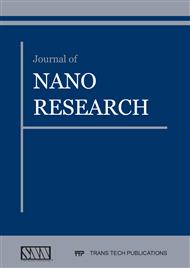[1]
S., Juna, S., Hayden, M., Damm, C. O., Kappe, & A, Huber. Microwave mediated preparation of nanoparticles from wx corn starch employing nanoprecipitation. Starch‐Stärke, 66(3-4), (2014), 316-325.
DOI: 10.1002/star.201300067
Google Scholar
[2]
A., Buléon, P., Colonna, V., Planchot, & S, Ball. Starch granules: structure and biosynthesis. International Journal of Biological Macromolecules, 23(2), (1998), 85-112.
DOI: 10.1016/s0141-8130(98)00040-3
Google Scholar
[3]
A., Buléon, G., Véronèse, & J. L. Putaux,. Self-association and crystallization of amylose. Australian Journal of Chemistry, 60(10), (2007), 706-718.
DOI: 10.1071/ch07168
Google Scholar
[4]
D. J., Gallant, B., Bouchet, & P. M. Baldwin,. Microscopy of starch: evidence of a new level of granule organization. Carbohydrate Polymers, 32(3-4), (1997), 177-191.
DOI: 10.1016/s0144-8617(97)00008-8
Google Scholar
[5]
D. J. McClements,. Nanoparticle-and microparticle-based delivery systems: Encapsulation, protection and release of active compounds. CRC Press, (chapter 2), (2014).
DOI: 10.1201/b17280-9
Google Scholar
[6]
S., Bloembergen, F. Kappen, and B. Beelen, Environmentally friendly biopolymer adhesives and applications based thereon U.S. Patent 6921430 B2,( 2005).
Google Scholar
[7]
H., Angellier, L., Choisnard, S., Molina-Boisseau, P., Ozil, & A, Dufresne, .. Optimization of the preparation of aqueous suspensions of waxy maize starch nanocrystals using a response surface methodology. Biomacromolecules, 5(4), (2004), 1545-1551.
DOI: 10.1021/bm049914u
Google Scholar
[8]
Y., Qin, C., Liu, S., Jiang, L. Xiong, and Q., Sun,. Characterization of starch nanoparticles prepared by nanoprecipitation: Influence of amylose content and starch type. Industrial Crops and Products, 87, (2016), pp.182-190.
DOI: 10.1016/j.indcrop.2016.04.038
Google Scholar
[9]
Y., Chang, X., Yan, Q., Wang, L., Ren, J., Tong, & J. Zhou,. High efficiency and low cost preparation of size controlled starch nanoparticles through ultrasonic treatment and precipitation. Food chemistry, 227, (2017), 369-375.
DOI: 10.1016/j.foodchem.2017.01.111
Google Scholar
[10]
A., Dufresne, J. Y., Cavaille, & W Helbert,.. New nanocomposite materials: microcrystalline starch reinforced thermoplastic. Macromolecules, 29(23), (1996), 7624-7626.
DOI: 10.1021/ma9602738
Google Scholar
[11]
F., Giezen, R., Jongboom, K., Gotlieb, A. Boersma,. Biopolymer nanoparticles. U.S. Patent WO 00/69916, January 25. (2000).
Google Scholar
[12]
J. Y., Kim, D. J., Park, & S. T. Lim,. Fragmentation of waxy rice starch granules by enzymatic hydrolysis. Cereal Chemistry, 85(2), (2008), 182-187.
DOI: 10.1094/cchem-85-2-0182
Google Scholar
[13]
H., Liu, F., Xie, L., Yu, L., Chen, & L. Li,. Thermal processing of starch-based polymers. Progress in Polymer Science, 34(12), (2009), 1348-1368.
DOI: 10.1016/j.progpolymsci.2009.07.001
Google Scholar
[14]
S. F., Chin, S. C., Pang, & S. H. Tay,. Size controlled synthesis of starch nanoparticles by a simple nanoprecipitation method. Carbohydrate Polymers, 86(4), (2011), 1817-1819.
DOI: 10.1016/j.carbpol.2011.07.012
Google Scholar
[15]
D., Bras, J., Le Corre, & A. Dufresne,. Starch nanoparticles: a review. Biomacromolecules, 11(5), (2010), 1139-1153.
DOI: 10.1021/bm901428y
Google Scholar
[16]
H. P. F. D., Fessi, F., Puisieux, J. P., Devissaguet, N., Ammoury, & S. Benita,. Nanocapsule formation by interfacial polymer deposition following solvent displacement. International Journal of Pharmaceutics, 55(1), (1989), R1-R4.
DOI: 10.1016/0378-5173(89)90281-0
Google Scholar
[17]
X., Wu, Y., Chang, Y., Fu, L., Ren, J. Tong, and J Zhou. Effects of non‐solvent and starch solution on formation of starch nanoparticles by nanoprecipitation. Starch‐Stärke, 68(3-4), (2016), 258-263.
DOI: 10.1002/star.201500269
Google Scholar
[18]
A., Hebeish, M.H., El-Rafie, M.A., E.L-Sheikh, M.E., El-Naggar. Ultra-fine characteristics of starch nanoparticles prepared using native starch with and without surfactant. J. Inorg. Organomet. Polym. Mater. 24 (3), (2014), 515–524.
DOI: 10.1007/s10904-013-0004-x
Google Scholar
[19]
H. Y., Kim, J. A., Han, D. K., Kweon J. D., Park, & S. T. Lim,. Effect of ultrasonic treatments on nanoparticle preparation of acid-hydrolyzed waxy maize starch. Carbohydrate Polymers, 93(2), (2013), 582-588.
DOI: 10.1016/j.carbpol.2012.12.050
Google Scholar
[20]
J. N., BeMiller, & R. L. Whistler, (Eds.).. Starch: chemistry and technology. Academic Press, (chater 10). (2009).
Google Scholar
[21]
Bertolini, A. (Ed.) Starches: characterization, properties, and applications. CRC Press, (chapter 5). (2009).
Google Scholar
[22]
R., Ricupero, N., C., Bucolo, F., Maugeri, A., Maltese, &, G. Puglisi. Preparation and characte Pignatello rization of eudragit retard nanosuspensions for the ocular delivery of cloricromene. Aaps Pharmscitech, 7(1), (2006), E192-E198.s.
DOI: 10.1208/pt070127
Google Scholar
[23]
H.Y., Kim, S.S., Park, S.T. Lim,,. Preparation, characterization and utilization ofstarch nanoparticles. Colloids Surface, B 126, (2015), 607–620.
Google Scholar
[24]
M.J., Santander-Ortega, T., Stauner, B., Loretz, J.L., Ortega-Vinuesa, D., Bastos-González, G., Wenz, U.F., Schaefer, C.M., Lehr,. Nanoparticlesmade from novel starch derivatives for transdermal drug delivery. J. Controlled Release, 141,(2010), 85–92.
DOI: 10.1016/j.jconrel.2009.08.012
Google Scholar
[25]
W. J., Wang, A. D., Powell, & C. G. Oates,. Pattern of enzyme hydrolysis in raw sago starch: effects of processing history. Carbohydrate Polymers, 26(2), (1995), 91-97.
DOI: 10.1016/0144-8617(94)00090-g
Google Scholar
[26]
M., Stasiak, M., Molenda I., Opalinski, &, W. Blaszczak. Mechanical Properties of Native Maize, Wheat, and Potato Starches. Czech Journal of Food Science, 31(4) (2013).
DOI: 10.17221/348/2012-cjfs
Google Scholar
[27]
K., Lammers, G., Arbuckle-Keil & J. Dighton,. FT-IR study of the changes in carbohydrate chemistry of three New Jersey pine barrens leaf litters during simulated control burning. Soil Biology and Biochemistry, 41(2), (2009), 340-347.
DOI: 10.1016/j.soilbio.2008.11.005
Google Scholar
[28]
S. M., Goheen, & R. P. Wool,. Degradation of polyethylene–starch blends in soil. Journal of applied polymer science, 42(10), (1991), 2691-2701.
DOI: 10.1002/app.1991.070421007
Google Scholar
[29]
M., Černá, A. S., Barros, A., Nunes, S. M., Rocha, I., Delgadillo, J., Čopı́ková,&, M. A. Coimbra. Use of FT-IR spectroscopy as a tool for the analysis of polysaccharide food additives. Carbohydrate Polymers, 51(4), (2003), 383-389.
DOI: 10.1016/s0144-8617(02)00259-x
Google Scholar
[30]
L, Paterson, JR, Mitchell, SE., Hil, and JMV. Blanshard. Evidence for sulfite induced oxidative reductive depolymerization of starch polysaccharides. Carbohydrate Research 292: (1996) 143–51.
DOI: 10.1016/s0008-6215(96)91039-3
Google Scholar


